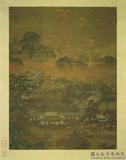明藍瑛仿黃公望山水 卷
推薦分享
資源連結
連結到原始資料 (您即將開啟新視窗離開本站)後設資料
- 資料識別:
- 故畫000931N000000000
- 資料類型:
- 類型:繪畫
- 型式:靜態圖像
- 著作者:
- 藍瑛
- 主題與關鍵字:
- 溪澗、湍泉 瀑布 高士(士人、隱士) 漁夫、船夫 行旅 百姓 松 水榭 房舍 寺廟 亭 橋
- 出版者:
- 數位化執行單位:國立故宮博物院
- 日期:
- 明思宗崇禎十二年(1639)
- 格式:
- 本幅 43.4x325.6公分、隔水一 15公分、隔水二 13公分
- 關聯:
- 石渠寶笈續編(御書房),第四冊,頁2087&*故宮書畫錄(卷四),第二冊,頁241-242&*故宮書畫圖錄,第二十冊,頁17-20&*1.〈明藍瑛仿黃公望山水〉,收入國立故宮博物院編,《晚明變形主義畫家作品展》(臺北:國立故宮博物院,1977年九月初版),頁314。 2.林柏亭著、盧素芬譯,〈黃公望的密碼?—「Y字型皴」初探〉,《故宮文物月刊》,第340期(2011年7月),頁4-21。 &* 藍瑛(西元一五八五-一六六四年尚存),字田叔,號蜨叟、西湖外史、晚號石頭陀,浙江錢塘人。藍瑛少年臨摹宋元諸家,於黃公望究心尤力。中年自立門庭,涉獵既多,故落筆縱橫奇古。 此卷構圖、造形、技法全師子久,筆墨渾樸中而自饒秀潤之氣。然而山頂礬頭,層疊累積,密處如同網孔,與吳彬互通聲息。畫作于明崇禎己卯(一六三九),田叔五十五歲。 &*Lan Ying, a native of Chekiang province, modeled his early style after the Sung and Yüan masters, particularly Huang Kung-wang. Later, however, his style was more individualistic and he experimented with heavier colors and thicker lines. In this work, Lan Ying presents layered peaks, streams, and mountain villages in a horizontal format. Aspects of the composition, form, and technique all reflect those of Huang Kung-wang’s style, but the use of brush and ink reveal his own originality. “Alum heads” are employed to articulate the summits of mountains and the layered peaks resemble a densely woven net, resonating with the style of Wu Pin. This work was done by Lan Ying in 1639 at the age of 54.
- 管理權:
- 國立故宮博物院
授權聯絡窗口
- 國立故宮博物院圖像授權、出版授權、影音資料授權-申請流程說明
http://www.npm.gov.tw/zh-TW/Article.aspx?sNo=03003061






